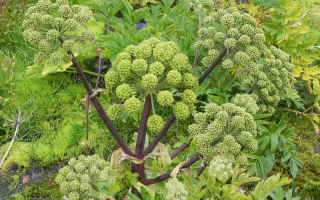Content
- 1 What does angelica look like
- 2 Where does the angelica grow
- 3 Angelica chemical composition
- 4 What is useful and what does angelica help from
- 5 The use of angelica root in traditional medicine
- 6 Application in cosmetology
- 7 Contraindications
- 8 Collection and procurement
- 9 Conclusion
- 10 Reviews of angelica medicinal
The healing properties of angelica root and contraindications are interesting to study for all connoisseurs of traditional medicine. Plant-based remedies are ways to bring beneficial effects even for serious diseases.
What does angelica look like
The medicinal angelica (Angelica archangelica) is a biennial plant from the Umbrella family. It can reach a height of 2.5 m, the stems are thick and straight, with a bluish bloom, branching closer to the ends. The photo and description of the medicinal angelica represent a herbaceous shrub with large, pinnately dissected leaves on small petioles. The development cycle is two-year, in the first year the plant consists only of a root and a leaf rosette, and in the second year it gives a tall, durable stem.

From June to August, angelica brings large "umbrellas", consisting of small and nondescript individually buds. The flowers of the plant are whitish or yellow-green, with almost invisible cups. In the fall, fruits appear in place of inflorescences - elongated oblong boxes, and up to 500 g of seeds can be collected from one bush.

Angelica is a honey plant and attracts bees during the flowering period. The smell of the plant is very pleasant and strong, sweet with musky notes.
The main medicinal value is the long and thick underground angelica stem up to 10 cm in diameter. In the upper part, numerous adventitious roots extend from it. If you cut the main rod in half, then a light yellow juice will come out of it abundantly.
Where does the angelica grow
The Chinese angelica is very widespread throughout almost the entire territory of Russia. You can see it in the Central region, from the Barents Sea to the middle zone, there is a biennial in the Urals and Western Siberia, as well as in the North Caucasus.
For growth, angelica chooses moist, but well-lit areas on the banks of rivers, forms thickets next to shrubs and in ravines, in wetlands of deciduous forests. Prefers slightly acidic or neutral soils.
Angelica chemical composition
The medicinal value of Chinese angelica is due to its rich composition. In the root and ground parts of the plant are present:
- monoterpenes;
- antioxidants sedanolide and legustilide;
- falcarindiol and falcarinol - anti-inflammatory substances;
- organic acids - valeric, malic, acetic;
- sugar and wax;
- resins and phytosterols;
- flavonoid diosmin;
- tannins;
- coumarins;
- vitamin C;
- phosphorus and calcium.
100 g of angelica root contains only 10 calories. Of the nutrients, proteins occupy the main share - 4.5%, followed by fats and carbohydrates - 3.5 and 2.2% each.
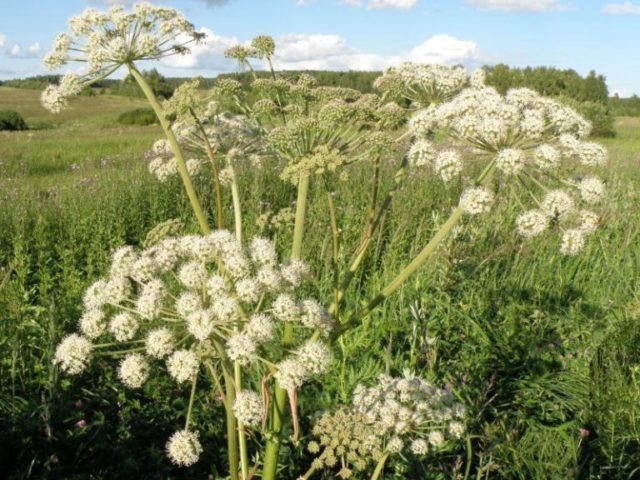
What is useful and what does angelica help from
With regular use, angelica root:
- normalizes the state of the nervous system and relieves insomnia;
- eliminates arrhythmia caused by stress and psychological stress;
- relieves inflammation and pain in rheumatism, arthritis and other joint ailments;
- helps get rid of shortness of breath;
- evens out blood pressure and strengthens blood vessels;
- improves digestion and helps fight bloating and flatulence;
- has a beneficial effect on varicose veins and a tendency to thrombosis;
- normalizes appetite;
- strengthens the immune resistance.
Angelica root extract can be found in many pharmaceutical preparations. The medicinal properties of the plant are officially recognized by traditional medicine.
Useful properties of angelica for women
It is useful for women to study the photo of the angelica plant and its healing properties. Means based on biennial dilate blood vessels, relieve pain during menstruation and improve general condition. You can use the herb during menopause, it evens out the hormonal background and helps to reduce the frequency of hot flashes.
Traditional medicine actively uses the properties of the angelica plant to treat gynecological diseases - mastopathy, endometriosis, uterine fibroids and polycystic ovaries. With the help of decoctions and infusions based on medicinal herbs, you can restore the normal menstrual cycle. Angelica helps even with infertility, if it is caused by poor blood supply to the pelvic organs and anemia.
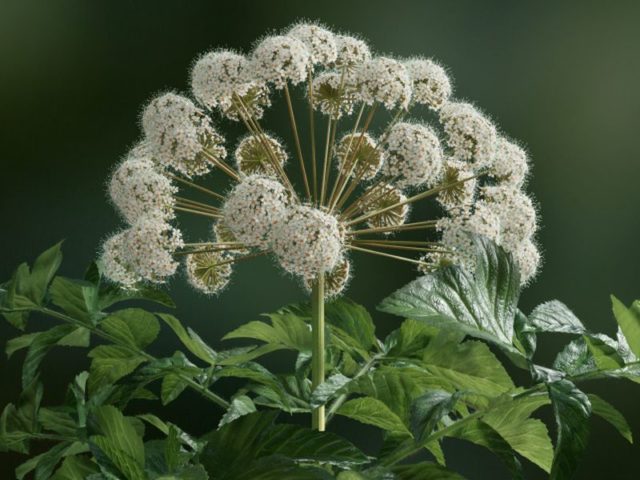
Medicinal properties of angelica root for men
Angelica's beneficial effect on hormonal levels is beneficial for the male body as well, the plant helps to normalize the balance of testosterone and estrogen. Angelica restores correct lipid metabolism, strengthens the heart and blood vessels in the stronger sex, and serves as the prevention of heart attacks and strokes.
You can use biennial root to improve potency. The medicinal properties of the herb angelica are good for treating infectious diseases of the genitourinary system.
The use of angelica root in traditional medicine
Homemade health recipes offer several options for using the Chinese angelica. Funds based on it are used both internally and externally.
Tincture
For digestive ailments, as well as for vascular and colds, a tincture on angelica root is beneficial. Prepare it like this:
- the raw material is crushed to a powder state;
- 3 large spoons of ground root pour 200 ml of alcohol or high-quality vodka;
- the product is removed for 12 days in a dark place;
- after the time has elapsed, the finished tincture is filtered through cheesecloth.
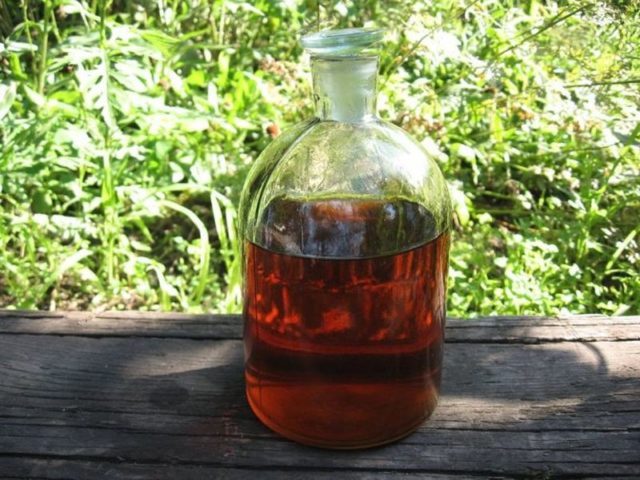
You need to drink the medicine 1 small spoon three times a day, angelica will help with gastritis, flatulence and ailments of the respiratory system. Externally, the agent is used for rubbing with rheumatism and osteoporosis, as well as with muscle injuries and sprains.
Infusion
When coughing, an aqueous infusion of angelica root has a good effect. To prepare it you need:
- pour 1 small spoonful of crushed rhizome into a thermos;
- pour 500 ml of boiling water;
- close the lid and insist for 8 hours.
The finished product must be passed through cheesecloth. Take the infusion three times a day on an empty stomach, 100 ml. A remedy based on angelica root can treat not only colds, but also muscle pain, gastritis, liver and pancreas ailments.

Decoction
A healthy drink based on angelica is a strong decoction of dry root. The recipe looks like this:
- the raw materials are crushed in a volume of 1 large spoon;
- pour 250 ml of water and boil for 5 minutes;
- then removed from heat and insisted under the lid for another 2 hours.
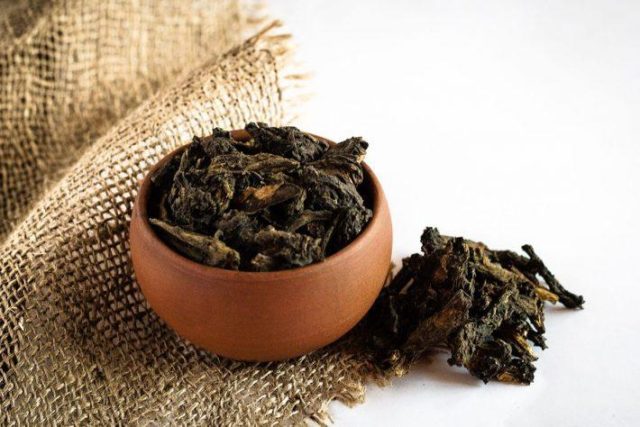
The strained broth should be taken in 50 ml, pre-mixed with a spoonful of natural honey. The medicine helps with chronic pancreatitis and gastritis, with high blood sugar, asthma and flatulence. Also, the broth has diuretic and diaphoretic properties, which makes it possible to use it to relieve edema and at temperature.
Tea
To prepare healthy and tasty tea, several medicinal herbs are taken at once. Specifically, the recipe suggests:
- mix in equal parts willow-tea, crushed angelica root and rosehip;
- add the same amount of chamomile and St. John's wort;
- Measure out 1 large spoonful of herbal tea and steep with hot water, like regular tea.

Angelica is good for strengthening the immune system, especially during the flu and cold season. You can also drink it 1-2 cups a day for stomach upsets, stress and loss of energy.
Oil
Essential oil is obtained from seeds and root of Chinese angelica by steam distillation. It is used for a variety of purposes, for example:
- for the treatment of viruses and bronchitis;
- to restore hormonal levels during menopause in women;
- to improve overall tone;
- to stimulate digestion.
Since the ether from angelica root has a concentrated composition, it is consumed in minimal dosages, adding 1-2 drops to teas or herbal infusions.
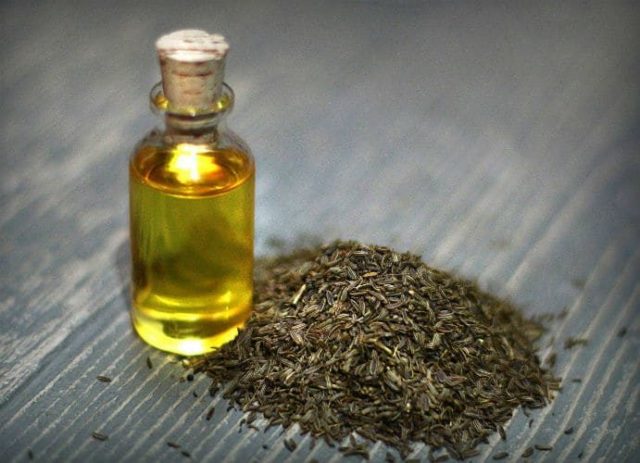
Angelica oil is widely used externally. For example, it is useful to treat the joints with it for rheumatism and arthritis, rub the agent into the chest for bronchitis. In this case, the ether must be diluted in any oil base so that it does not leave a burn on the skin.
Ointment
Using a medicinal herb, an ointment is prepared for skin ailments and inflammation. Prescription requires:
- mix the crushed angelica root with honey, wax, spruce resin and linseed oil in a ratio of 2/1/1/1/1;
- boil over low heat for 20 minutes;
- turn off the stove and add a little lamp oil to the still warm mixture;
- strain and put in the refrigerator to solidify.
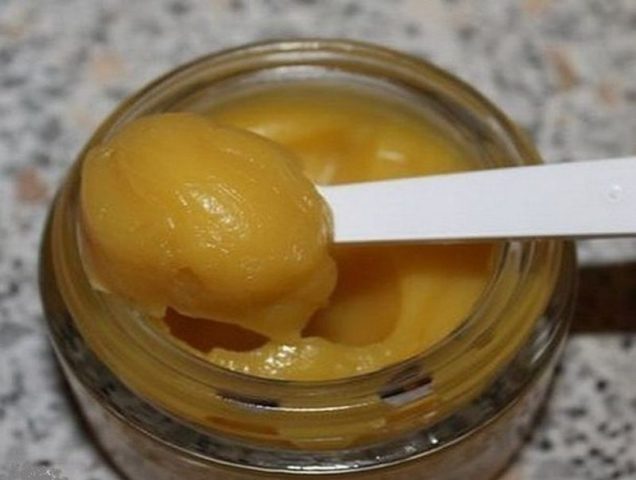
The finished product is used to treat cuts, healing burns and inflamed wounds. You can use the ointment for dermatitis and eczema.
Another recipe suggests preparing a special ointment for parasites. It is necessary:
- mix a small spoonful of angelica with a large spoonful of cheremitsa root;
- add 4 large tablespoons of pork fat to the ingredients;
- to stir thoroughly.
The healing mixture can be rubbed on the body when infested with linen lice and mites to get rid of insects faster.
Powder
Dry powder from the root and green parts of angelica can be mixed in equal proportions with honey and used as a compress for wounds and scratches. The tool has healing properties and helps to quickly restore the integrity of the skin.
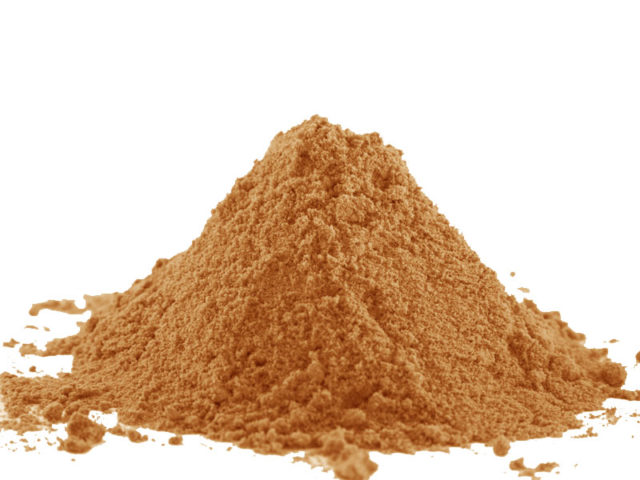
In case of poor digestion, gastritis and diseases of the bladder, the powder is used internally.Only 0.5 g of the product is dissolved in 100 ml of water and drunk on an empty stomach three times a day.
The juice
Angelica root juice has strong analgesic properties. It is used:
- with caries, 1 drop of fresh juice must be dropped into the hollow of the problem tooth;
- with otitis media - the agent is instilled into the ears twice a day, 3 drops;
- with a runny nose, 2 drops will be enough for each nostril.

Also, the juice has a good effect on pancreatitis and jaundice, for 3 weeks you need to take 1 small spoonful of the product three times a day.
Application in cosmetology
Angelica root products are often used for skin and hair care. In particular, the oil helps to moisturize and tighten the epidermis, alcohol tincture relieves acne. Water decoctions nourish the skin with beneficial substances and have a rejuvenating effect.
Angelica roots contain a large amount of coumarins and therefore contribute to the renewal and regeneration of the epidermis. Against the background of the use of angelica, the production of collagen in the body improves, it is this substance that is responsible for the youthfulness of the skin and the health of the hair.
Infusion for irritated skin
If the epidermis is heavily peeling, and microcracks often appear on the face, you can use this tool:
- a small spoonful of crushed root is poured with a glass of boiling water;
- insist only 10 minutes;
- filter and wait until the product cools down.
The infusion is used in the morning and in the evening for washing, or simply moisten a cotton pad in it and wipe the face. If you repeat the procedure every day, your skin will quickly become softer and healthier.
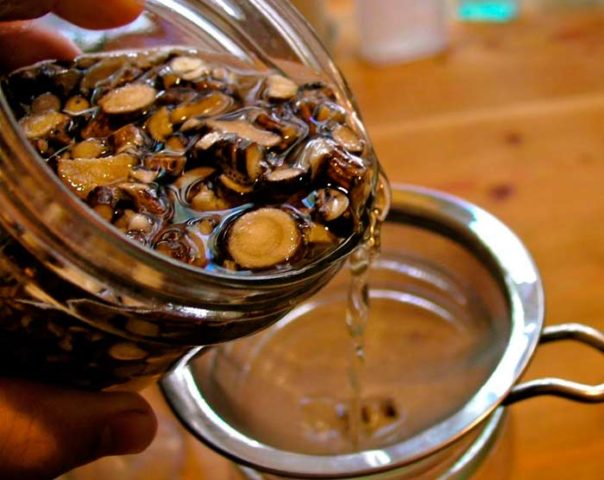
Anti-wrinkle mask
This home remedy helps with fine wrinkles:
- a small spoonful of angelica broth is mixed with the same amount of honey;
- add a large spoonful of natural cottage cheese;
- bring the mixture to homogeneity and apply on the face for 15 minutes.
The mask has a strong moisturizing and softening effect. It will not help against deep folds, but it will eliminate the first wrinkles quickly.
Hair rinse decoction
The valuable properties of angelica root can be used in hair care. To strengthen the curls and return them to a healthy shine, the following decoction allows:
- 5 large spoons of dry raw materials pour 2 liters of liquid;
- boil for about 10 minutes;
- insist another half hour and filter.
The broth is added with 1.5 liters of fresh water and the strands are washed with it after each wash. Regular rinsing stops hair loss, adds fluffiness and dandruff.
Contraindications
In most cases, Chinese angelica is beneficial, but sometimes it can be harmful. It is not recommended to use it:
- if you have an individual allergy;
- with stomach ulcers and diabetes mellitus;
- with tachycardia and chronic heart disorders;
- with poor blood clotting.
It is necessary to abandon the use of the plant for pregnant women at any time, as well as for nursing mothers.
The benefits and harms of angelica depend on the accuracy of following proven recipes. If the dosage is exceeded, then the Chinese angelica can cause not only diarrhea and vomiting, but also dizziness, loss of consciousness and even paralysis.
Collection and procurement
For medicinal purposes, all parts of the Chinese angelica are used. But if the leaves and flowers can be harvested in spring and summer, then the rhizomes are harvested in the fall, when the angelica accumulates a maximum of useful substances:
- A herbaceous shrub is dug out of the soil, the ground part is cut off, and then the rods are well washed using a brush.
- Raw materials are cut into longitudinal strips and dried in an oven at a temperature of about 50 ° C.
- You can decompose angelica in the fresh air in dry and warm weather, but in this case, the moisture from the root will evaporate only after 10 days.

Store raw materials in dry glass jars with tight lids, away from the sun, with low humidity.Subject to the rules, the underground parts of the angelica remain useful for 3 years.
Conclusion
The healing properties of angelica root and contraindications are very diverse. When using the plant, it is important to observe the dosage, in which case the angelica will help to cope with inflammatory and digestive ailments.
Reviews of angelica medicinal

